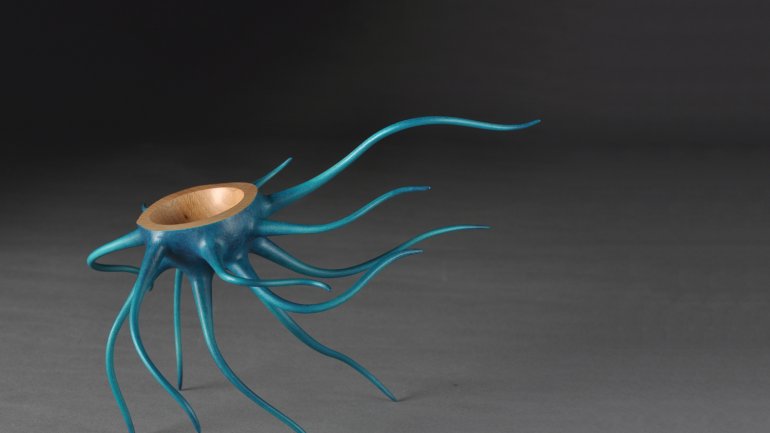Microorganisms in Maple
Microorganisms in Maple
A decade ago, Kristin LeVier shifted from researching the behavior of bacteria to shaping and carving intricate wood sculptures. The transition puzzles some people.
“I’m often asked how I could go from work that uses the left brain to something that uses the right,” says LeVier, who lives in Moscow, Idaho. “But that’s not the case. If you do good science, you have to be creative. And in art, there’s a lot of problem solving.”
In fact, LeVier, 48, has had a hand in both worlds for decades. Growing up, she always painted and drew. In her early 20s, while studying for her PhD in molecular biology at Dartmouth College, she stumbled onto woodworking as an escape from the books.
“Dartmouth had a workshop where you could walk in without knowing how to do anything,” she says. “It was run by two amazing men, and they taught you from square one.” It helped that she’s a perfectionist who follows directions well.
From there, a series of research jobs kept LeVier connected to universities that happened to have woodshops, and she continued to make small pieces of furniture for fun.
When her husband, a stream ecologist, took a job at the University of Idaho in 2005, she decided to stay home with their 2-year-old son and try woodworking full time. She figured she’d make small functional pieces to sell at art fairs. But a chance introduction to renowned wood artist Jim Christiansen changed her course again.
“He is a born educator and has taught me so much,” she says. “One day, Jim said, ‘Do you want to be a woodworker, or do you want to be an artist?’ I started crying on the spot. I wanted to be an artist, but I hadn’t had the courage to say that.”
Shortly after they met, Christiansen invited her to share his workshop, and a few years ago they moved into a larger space with fellow woodworker Ben Carpenter.
Science and nature inform and inspire much of LeVier’s work. Some sculptures conjure colorful cells with wiggly cilia, while a spoon handle morphs into sinuous chive leaves. In the Contemporary Taxidermy series, curved segments of wood resemble vertebrae.
“I think that looking at the world through science gives me a broader sense of what’s beautiful. Like who’s going to look at a chive and say, ‘Oh, that’s incredible’?”
She takes her dual role as artist and scientist seriously. “If you’re just talking to me, I’m kind of silly and goofy, but when I’m making a sculpture, I’m very earnest and serious,” she says. “I try to make it filled with the wonder I see. I feel like these things are achingly beautiful.”
To achieve her fluid, natural forms, LeVier uses compressed hardwood, a material that Christiansen told her about when she wondered how she could manipulate the wood for a piece she’d had in her mind for a decade.
“People have been bending wood forever, but through steaming,” she says. “What I can do with compressed wood is bend it when it’s not steaming-hot, and with my hand, very intuitively. I twist and turn it, and then hold it in front of a hairdryer to dry.”
Since working as an artist full time (after-school time is devoted to her two children, ages 10 and 13), LeVier has quickly become recognized in juried shows, winning awards and gallery invitations.
“I feel like I’m on the verge of big change – right on the edge,” she says.
Some of that has to do with growing her business, but the challenge is also artistic. “I’d love to do something so big that it completely terrifies me.”
Four LeVier pieces will be included in an Arrowmont instructors exhibition at the Folk Art Center in Asheville, North Carolina, opening in mid-February. Diane Daniel is a writer based in Florida and the Netherlands.

